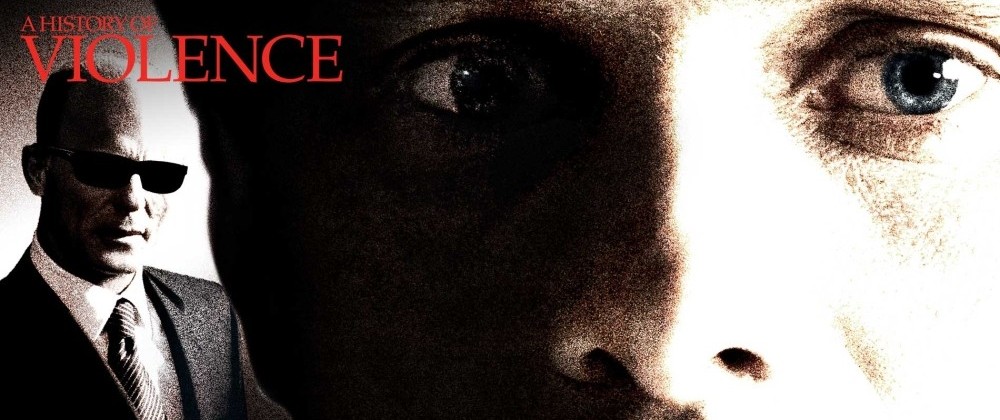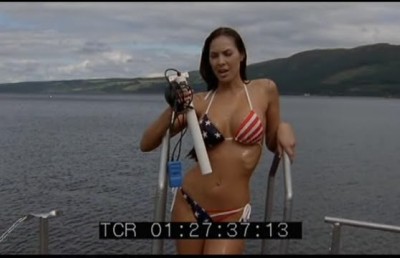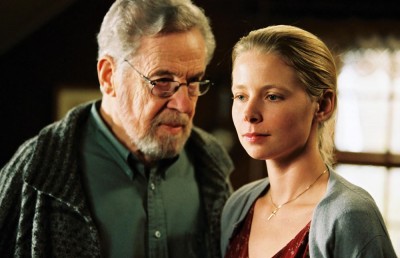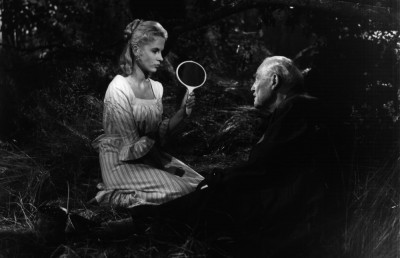A History of Violence….sort of
Contemplating Screen Violence

David Cronenberg’s A History of Violence comes at an interesting moment where several of North America’s reigning auteurists have released films within months of each other in the calendar year 2005: fellow Canadian Atom Egoyan (Where the Truth Lies), Jim Jarmusch (Broken Flowers), Gus Van Sant (Last Days), and Steven Spielberg (War of the Worlds). A few generalities can be made about this concurrence. I would not go as far as saying that these directors are treading artistic water, but that none of the films represent a major breakthrough in terms of style or theme for the respective director. Van Sant’s Last Days forms a perfect fit as an installment in a ‘minimalist’ trilogy with Gerry and Elephant. With Broken Flowers Jim Jarmusch delivers a spruced up (with bigger name cast) version of his usual deadpan humor and stately visual style.
To digress slightly, Broken Flowers makes an interesting comparison to a film made by one of Jarmusch’s cinema heroes, Michelangelo Antonioni, Il Grido (1957). Both being ‘road movies’, in Il Grido we have a similar narrative arc where a man is moved by a woman to retrace his past. Both films begin with a woman (Alida Valli as Irma in Il Grido and Julie Delpy s Sherry in Broken Flowers) deciding to end the relationship with the male protagonist (Steve Cochran as Aldo in Il Grido and Bill Murray as Don Johnston in Broken Flowers). This decision alone triggers Aldo’s journey in Il Grido, while in Broken Flowers the breakup is compounded by an anonymous letter from a former lover telling Don Johnston that she had a child from him which he knew nothing about. Like Don Johnston in Broken Flowers, Aldo (Steve Cochran) goes on what William Arrowsmith has called a “psychogeographical” journey [1] along the Po River meeting up with a former girlfriend and sputtering into two other transient relationships. Like Johnston, the experience bears little fruit. In Broken Flowers Johnston’s “psychogeographical” journey ends with him standing in the middle of a street, having perhaps caught a glimpse of the son he perhaps has who perhaps may be searching him out, and the camera dollying 360 degrees around him, the circular camera movement entrapping him as much as his own emotional inertia. The film ends with Johnston unable to break out of the circle which has come to signify his stunted, joyless life, which stands in stark contrast to the joyful, exuberant, life and family of his friend and neighbor Winston (Jeffrey Wright). In Il Grido, however, Aldo also returns to square one, his home town and the tower of the sugar refinery where he once worked, but is able to break through the hopeless circle by falling from the tower to his death (although many critics refer to this as a suicide, the actions of the character may suggest that he lost his balance and fell over).
Things differ slightly with Cronenberg and Egoyan, who have made films that are far more accessible than their earlier works. In the case of Cronenberg, the film has become commercially successful largely because of the recognizable actors (Viggo Mortensen, Ed Harris, Maria Bello, William Hurt) and subject matter (violence, revenge). The point of opening up to a larger potential market is even stronger for Egoyan, whose Where the Truth Lies, a ‘mystery’ biopic of a Martin and Lewis-like comedy team that intercuts between the 1950s and 1970s, steers clear of the formal distanciation which has marked his previous films, and is usually a surefire way to alienate the mainstream. Jarmusch’s latest can also be considered more “user-friendly” than his previous films, largely on the presence of several marquee actors (Bill Murray, Sharon Stone, Julie Delpy) and a less rigorous formal control than such films as Permanent Vacations, Stranger than Paradise, Down by Law, and Dead Man. One could easily argue that with respect to pedigree and authorial intent, Spielberg’s film is far more successful than any of the other. Spielberg would never aspire to the minimalism or distanciation of a Van Sant or Egoyan, but War of the Worlds is a cracker of a science fiction thriller which gives evidence to the best of Spielberg –the use of technique to thoroughly engage an audience– while keeping to a minimum the worse of Spielberg –the overuse of emotional manipulation– which only appears in the end when the missing son is revealed to be alive. One may feel disappointed in this lack of breaking any new ground, but as Jean Renoir once said, each director spends their career remaking the same film.
In A History of Violence Viggo Mortensen plays a small-town, hard working American family man named Tom Stall (the symbolism of the name is hard to miss), married to a perfect wife Edie (Maria Bello) with two wonderful children, the teenage Jack (Ashton Holmes) and younger Sarah (Heidi Hayes). Stall’s idyllic life is shattered after he is placed in a situation where he must act the hero. A pair of serial killer drifters, sighted in the film’s impressive if obvious opening, happen into his coffee shop and terrorize both Stall, his customers, and an employee. When faced with the certain rape and murder of a victim Stall reacts by upending the bad guys and killing both of them (and these two are really bad guys, without any of the comical, self-parodic redeeming values of the later bad guys, played by Ed Harris and William Hurt). Within days of media coverage and local adulation, Stall becomes a folk hero. The material here is clearly in the camp of a revisionist Western, with Viggo as the dual character gunslinger trying to exorcise his past and live a ‘normal’ life. Like the classic Western, Stall represents the violence that was once necessary to establish and make real the American Dream (or Manifest Destiny in the case of the Western), but that is now no longer necessary or is so only when ‘forced.’ In the classic Western this ambivalence toward the necessary violent past is weaved into the fabric of the lone gunslinger, who is never able (or allowed) to settle into the peaceful town or peaceful existence he (and his kind) was instrumental in establishing and enforcing. In A History of Violence the violent past is erased and weaved into the social fabric of America, represented by Cronenberg’s all-too-perfect small town, until that past is summoned by another of Stall’s ‘kind’: another gunslinger dressed in black, Carl Fogarty (Ed Harris), who has come back to unsettle the dust. One would think that with a title as such –A History of Violence– Cronenberg would deal with the issue more than just as a dramatic device, but this is not really the case. [2] Or more accurately, the film says nothing more on the question of the role of violence in a ‘civilized’ society (i.e. America) than a good western like John Ford’s My Darling Clementine (1947), Henry King’s The Gunfighter (1950), George Steve’s Shane (1954), or Clint Eastwood’s Unforgiven (1992). In fact I would say that Eastwood’s Unforgiven, made 13 years ago, says more on the issue of violence (and its abuse) as an integral aspect of American culture. Or indeed so too do Wes Craven’s early horror films Last House on the Left (1972) and The Hills Have Eyes (1977).
However, I do not want to give the impression that A History of Violence is a bad film or an irresponsible film. Indeed the general critical consensus has been good for A History of Violence, although critics do seem to be divided on its value as a social critique, perhaps being led as much by the expectations suggested by the film’s title. Some critics read the film as an ironic display of how closely aligned the American dream is with a form of aggression and violence which is implicitly accepted as an end justifying a means (the essay by Amy Taubin in Film Comment Sept./Oct. 2005 is an example). While some critics reflect a certain discomfort with the way the film’s engrossing narrative use of violence sits with its critique of violence (if intended by Cronenberg or read into by the viewer). As much as I enjoyed the film, and value Cronenberg as a major director, I would have to count myself among the latter; partly because I found myself willingly implicated in Tom Stall’s crisis and cheering for him to somehow resolve it for the sake of himself and his family. My sense is that it is all too easy for audiences to identify with the ‘everyman’ hero Tom Stall, especially in contrast to the rather comic book villains played with devilish glee by William Hurt and Ed Harris. In other words, I felt there was not enough of the sort of ironic detachment from his crisis which would have made the use of violence both a) less dramatically relevant and b) less emotionally arresting. But on the other hand, it is precisely these last two points –which are by no means little artistic achievements- which have made the film more commercially successful than other Cronenberg films.
The film begins strong. Two ‘gunslingers,’ one an older man dressed in black from head to toe (Stephen McHattie), the second a younger man (Greg Bryk), exit a small motel and return to their convertible car. The camera tracks right with them as the car moves ahead slowly. The guy in black returns to the motel office to finish off some apparent business. He returns and instructs his partner to go back into the office for some cold bottled water. Although we have yet to see any evidence of foul play, the audience is sufficiently warned through Cronenberg’s cool stylistics and the demeanor of the two men to expect the worse. When the young man enters the office we see, along with him, the ugly aftermath of a violent rampage: two dead people lying in their blood. A little girl exits from a closed side door, and the young man turns to point a gun at her. We hear a gunshot, and the scene cuts to a close-up of another screaming little girl: we are now spatially removed to the Stall’s residence, his daughter waking from a nightmare where she dreamt of monsters. Stall tells her frightened daughter that there are no such things as monsters, a juicy bit of irony given that we will soon learn that her own father hides a monster-within: a ruthless, sadistic hired killer for the mob.
As noted Tom Stall’s idyllic American Dream life is shattered when the two criminals from the opening motel scene stop off at his diner with rape and murder in mind. Before the two killers arrive at Stall’s coffee shop there is a nice moment where the two killers are seen driving through the town with nothing but contempt for this small quaint town, and disgusted by the fact that they have to subsist by them. Moments before his waitress is to be raped, Stall reacts by scalding the criminal dressed in black with (black) coffee, then using his gun to shoot the second, younger criminal, and then returning to the first fallen man to blow his face away with a short range shot. Rather than expressing disgust that something like this has happened in their backyard, the town folk and media, who are all too easy prey for Cronenberg, hail him as a hero.
Like a western, the main dynamic is of a society (here the U.S., but as Cronenberg has said, could be any large, democratic nation) founded on violence/war, a nation built on the strength and skills of such people trained in violence, and being unable to fully accept this past by ‘hiding’ the culprits within their own (the once hit man Joey Cusack becomes clean cut Tom Stall). This theme is made worse in the end when the sheriff, the protector of the law, who knows about Stall’s past, or seriously suspects that something does not add up, turns a blind eye to the violence. Likewise his wife Edie and family initially spurn him only to accept him back into the fold, in an ending which recalls Michael Cimino’s Vietnam-inspired The Deerhunter, where a family ambivalently reconciles with America after the traumatic violence of the Vietnam war by singing God Bless America around a dinner table. Rather than make us loathe the ‘antihero’ or his violence, we actually root for Tom Stall; and unlike Unforgiven, where we are forced to face the very real abusive violence of the Gene Hackman ‘sheriff’ antihero Little Bill Daggett, there is no character similarly aligned in A History of Violence. The violence in A History of Violence is not glamorized, and in fact is made very ugly through short, confrontational formal bursts, but when Stall is placed in positions of having to outdo the bad guys –with Ed Harris and later his brother played by William Hurt– we want him to succeed, hence unconsciously or consciously ‘enjoy’ the violence.
The closest the film comes to a direct George Bush, post-9/11 allusion/critique is when Sheriff Sam Carney (Peter MacNeill) tells Stall, “Don’t worry, we take care of our kind here” (I am paraphrasing). It is also unsettling to see Stall’s son Jack, a seemingly timid and passive boy, react to the constant taunting and abuse at the hands of the high school bully by ‘snapping’ and beating him to a pulp, especially in light of the Columbine murders (the revelation of a violent streak within the timid exterior can be seen as a large metaphor for the U.S.). Later when Tom Stall is held at gunpoint by Carl Fogarty, the son saves his father by blowing away Fogarty from behind with the family shotgun. (A veiled justification for the NRA? Probably not from someone like Cronenberg, but it certainly can be seen that way by someone who is so inclined). Thematically the film is filled with cliché truisms which have worked very well dramatically for film: “You can’t escape your past.” “You can’t change who you are.” “We all have our personal demons within us.” “Behind every small town lurks an ugly secret,” etc. But perhaps stretching the theme beyond the immediate singular context of a family in crisis, to a broader social or political message places too heavy a strain on the film. Cronenberg has never been known as a director with hidden social or political agendas, and draws his strength from personal crisis. Which is why he was so fundamental in the cycle of ‘body horror’ films in the late 1970s, early 1980’s with The Brood (1979), Scanners (1981), Videodrome (1983) and The Fly (1986).
The potential range of horror within the family politic is cleverly depicted in pure Cronenbergian style in the two reflecting sex scenes in A History of Violence. In the first sex scenes Edie playfully ‘seduces’ her husband Tom by taking him to a motel where she role plays as a teenage cheerleader and initiates a fairly explicit (for mainstream cinema) 69 oral position. The sex is fun, healthy, and invigorating. The second sex scene occurs much later in the film and is, symbolically, initiated by the male, Tom, and is brutal, painful and violent. Rather than being consensual, this is a rape scene, as Tom forces Edie to have sex on the most uncomfortable setting imaginable: on the hard wood stairs of their two-story house. Cronenberg is no stranger to sexualized violence, having used it to great narrative relevance in such previous films as Shivers (1975), Rabid, The Brood, Videodrome, Dead Ringers, Crash (1996), and eXistenZ (1999). Being one of the great taboos of American cinema, this use of sexualized violence within a domestic setting is, I would suggest, the most daring and subversive element of A History of Violence.
Perhaps, as some critics have suggested, the film is really about one man’s descent into his own inner demon; and the destruction it causes a family, and the way a family manages to survive through the traumatic event by emotional resilience, trust, and honesty (well, maybe not honesty, since the tough lawyer-wife Edie clearly lies to the Sheriff to save her husband…I guess that must be why she was cast as a lawyer, since we don’t ever see her ‘work’ otherwise). If so, the title should have been something less grandiose, since we don’t get the sense that Cronenberg wanted to deal with this issue on a broader scope. However, Cronenberg is too good a filmmaker to make things too obvious. The result is a film which leaves a great onus of meaning to the interpretive whims and skills of each viewer. In doing so Cronenberg has made a film which resists easy and pat responses. At its best it is a film that challenges the viewer to respond critically and intellectually to whatever emotions the film may illicit. At its worse it is a film which risks succumbing to the very dynamics and mechanisms of screen violence that the subtext hopes to critique.
1 William Arrowsmith. Antonioni: The Poet of Images. Edited and Introduction by Ted Perry. Oxford: Oxford University Press, 1995, 23.
2 In a personal correspondence, frequent Offscreen contributor Daniel Garrett raised an important nuance concerning the film’s title which I had not considered: “The title ‘A History of Violence’ is very different from ‘The History of Violence’ and ‘A History of Violence’ is a phrase often used (in the U.S.) in official reports –arrests, juvenile reports, custody battles, legal proceedings– and it is usually understood that if someone has a history of violence, he’s likely to return to violence, it’s part of his definite and likely range of possibilities, whereas ‘The History’ would more likely refer to general, public, or social conditions. Yet how people respond to one man’s history of violence–and its current use in his life–may say something about society.” I thank Garrett for his observation.














